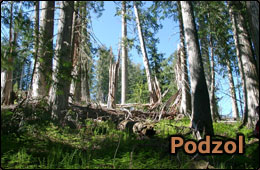Soil Site Details: UBC Malcom Knapp Podzol
Soils on this site are classified as Podzols. Many would consider the Podzols to be the most visually striking soils in Canada. Podzols are one of the most common soils found under coniferous (evergreen) forests.
Basic Facts
Soil Order: Podzol
Ecosystem: Coniferous Forest
Climate Zone: Humid Maritime
BC Biogeoclimatic Zone: Coastal Western Hemlock
Location: UBC Malcom Knapp Research Forest
City, Region, Country: LFV near Vancouver, British Columbia, Canada
Lat / Long: 49.27403/ -122.57
Soil Order: Podzol
Great Group: Humo-Ferric Podzol
Subgroup: Orstein Humo-Ferric Podzol
Soil Series: Capilano
Classification Code: OT.HFP
Soil Horizons Present: F, H, Ap, Ae, Bhf, Bfc, BC
Diagnostic Horizon 1: Bhf
Diagnostic Horizon 2:
Diagnostic Horizon 3:
Diagnostic Horizon 4:
Land Form: Glacio-fluvial
Parent Material: Glacio-marine deposit topped with glacio-fluvial outwash
Elevation (m): 170
Topography: Inclined
Affected by Glaciation: Yes
Climate Zone: Humid Maritime
Mean Annual Temperature (C): 9.8
Minimum Annual Temperature (C): 5
Maximum Annual Temperature (C): 14.6
Mean Annual Precipitation (mm): 2500
Current Land Use: 2nd-growth forest
Original Vegetation: Western hemlock, western red cedar
Current Vegetation: Douglas fir, western hemlock, western red cedar
PDF with details: 7_Capilano.pdf
Soil texture horizons: Sandy loam (Ap), Sand (Bhf, Bfc, BCgj, and C)
Soil structure horizons: Weak granular (Ap), single grain, structureless (Bhf, Bfc and BCgj)
Forest Humus Form:
Presence of Charcoal:
Presence of Coatings:
Primary Soil Process: Podzolization
Secondary Soil Process:
Links
Resources home: Principles, Land use, awareness, etc.
Processes: Podzol
Classification: Podzol
Virtual soil monoliths: via the left-side expanding menu.
Media

Podzol, from https://processes.soilweb.ca/podzol/.
Featured Expert: Dr. Tim Ballard
Video host: Dr. Art Bomke